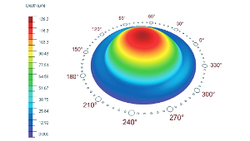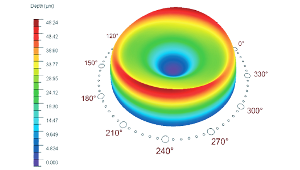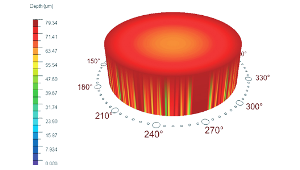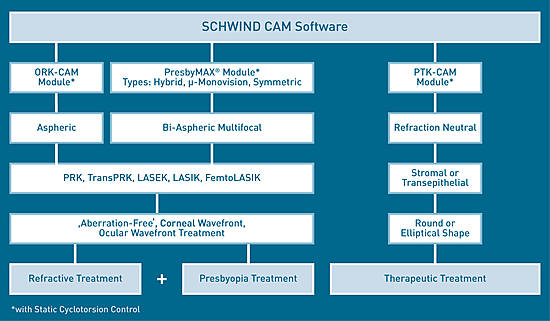
ORK-CAM
The ORK-CAM is an intelligent planning tool for refractive laser treatment. Aspheric ablation profiles are employed for "Aberration-Free" and "Customised" treatments.
"Aberration-Free" treatment
Only spherical and/or cylindrical refraction values are corrected. The patient retains his normal visual perception.
"Customised" treatment
Corneal or ocular wavefront data from the high-resolution SCHWIND diagnostic systems are directly integrated into planning.
Assymetrical centration strategy
A treatment offset can be already entered during planning for the centring of sphere and cylinder within the treatment zone. Whichever treatment method is employed (“Aberration-Free” or “Customised”), the difference between the centre of the pupil and the visual axis/corneal vertex is taken into account. The treatment zone remains concentric to the centre of the pupil. The otherwise required enlargement of the optical zone is not necessary.
"Minimise" functions
The ablation volume and depth can be adjusted in customised treatments. The advantage: less tissue ablation and shorter ablation times.
Intelligent dynamic transition zone
For every treatment, the ORK-CAM calculates the optimal size of the transition zone, dependig on the refraction, treatment method, and selection of the optical zone.
TransPRK
The TransPRK function allows "no-touch" surface treatments - the highly precise and easy removal of the epithelium and refractive laser treatment in one step.
The ORK-CAM is an intelligent planning tool for refractive laser treatment. Aspheric ablation profiles are employed for "Aberration-Free" and "Customised" treatments.
"Aberration-Free" treatment
Only spherical and/or cylindrical refraction values are corrected. The patient retains his normal visual perception.
"Customised" treatment
Corneal or ocular wavefront data from the high-resolution SCHWIND diagnostic systems are directly integrated into planning.
Assymetrical centration strategy
A treatment offset can be already entered during planning for the centring of sphere and cylinder within the treatment zone. Whichever treatment method is employed (“Aberration-Free” or “Customised”), the difference between the centre of the pupil and the visual axis/corneal vertex is taken into account. The treatment zone remains concentric to the centre of the pupil. The otherwise required enlargement of the optical zone is not necessary.
"Minimise" functions
The ablation volume and depth can be adjusted in customised treatments. The advantage: less tissue ablation and shorter ablation times.
Intelligent dynamic transition zone
For every treatment, the ORK-CAM calculates the optimal size of the transition zone, dependig on the refraction, treatment method, and selection of the optical zone.
TransPRK
The TransPRK function allows "no-touch" surface treatments - the highly precise and easy removal of the epithelium and refractive laser treatment in one step.

PresbyMAX allows the safe and efficient treatment of emmetropic, myopic and hyperopic patients as well as patients with astigmatism whose accommodative response is restricted.
With the PresbyMAX module, it is now possible to choose between three different treatment types.
PresbyMAX Symmetric
treats the dominant and non-dominant eye equally regarding depth of focus and the refractive target, thus ensuring optimal near vision
PresbyMAX µ-Monovision
PresbyMAX µ-Monovision creates the same depth of focus in both eyes. However, the dominant eye focuses slightly more towards near vision. The result: A faster visual recovery and better intermediate and far vision quality.
PresbyMAX ® Hybrid
is the latest generation and is also based on different target values. But in contrast to µ-Monovision, a different depth of focus is generated in the dominant and non-dominant eye. This ensures an extremely fast visual recovery and an especially high quality of distance vision.
Bi-aspheric multifocal profiles For each of the patient’s eyes, the central region of the cornea is optimised for near vision and the peripheral region for far vision.
Binocular vision
Both eyes equally contribute to providing visual acuity at all distances. Both eyes are active in the visual process and ensure binocular perception.
Comfortable vision at all distances
PresbyMAX optimally increases the depth of focus and minimises contrast losses.
Unique widely range of treatments
Every visual condition can be corrected with either aberration-free or customised treatment – whether PRK, TransPRK, LASEK, LASIK or FemtoLASIK.
Ablation of the combined ablation volume
The SCHWIND AMARIS ablates the combined ablation volume gently by the flying spot method - in just one step and without any interruptions.
Presby Reversal
This function makes it possible to remove the induced multifocality partially or entirely.
With the PresbyMAX module, it is now possible to choose between three different treatment types.
PresbyMAX Symmetric
treats the dominant and non-dominant eye equally regarding depth of focus and the refractive target, thus ensuring optimal near vision
PresbyMAX µ-Monovision
PresbyMAX µ-Monovision creates the same depth of focus in both eyes. However, the dominant eye focuses slightly more towards near vision. The result: A faster visual recovery and better intermediate and far vision quality.
PresbyMAX ® Hybrid
is the latest generation and is also based on different target values. But in contrast to µ-Monovision, a different depth of focus is generated in the dominant and non-dominant eye. This ensures an extremely fast visual recovery and an especially high quality of distance vision.
Bi-aspheric multifocal profiles For each of the patient’s eyes, the central region of the cornea is optimised for near vision and the peripheral region for far vision.
Binocular vision
Both eyes equally contribute to providing visual acuity at all distances. Both eyes are active in the visual process and ensure binocular perception.
Comfortable vision at all distances
PresbyMAX optimally increases the depth of focus and minimises contrast losses.
Unique widely range of treatments
Every visual condition can be corrected with either aberration-free or customised treatment – whether PRK, TransPRK, LASEK, LASIK or FemtoLASIK.
Ablation of the combined ablation volume
The SCHWIND AMARIS ablates the combined ablation volume gently by the flying spot method - in just one step and without any interruptions.
Presby Reversal
This function makes it possible to remove the induced multifocality partially or entirely.

TK-CAM Module
The PTK-CAM module is employed in the therapeutic treatment of superficial corneal scars, recurrent corneal erosion, corneal dystrophy and corneal degeneration. PTK-CAM is based on the method of phototherapeutic keratectomy (PTK).
Preoperative treatment planning
You can use PTK-CAM to plan and also save the requisite ablation profiles.
Two offset options
The ablation offset allows the entire profile to be moved in accordance with the pathological findings. The profile can be shifted to the corneal vertex with the help of the pupil offset.
Transparency and the highest possible precision
Simultaneous use of the two options guarantees transparency and the highest possible precision. This allows the exact, topographical localisation of superficial scars and minimises the tissue ablation volume.
Circular or elliptical
The PTK-CAM module can ablate the tissue in both circular and elliptical shapes within a maximum diameter of 10 millimetres.
Two ablation versions
The epithelium can be removed manually followed by the laser ablation; or the ablation can be performed as so called TransPTK through the epithelium.
Refraction neutrality
The profile takes into account the different ablation behaviour of the epithelium and stroma.
The PTK-CAM module is employed in the therapeutic treatment of superficial corneal scars, recurrent corneal erosion, corneal dystrophy and corneal degeneration. PTK-CAM is based on the method of phototherapeutic keratectomy (PTK).
Preoperative treatment planning
You can use PTK-CAM to plan and also save the requisite ablation profiles.
Two offset options
The ablation offset allows the entire profile to be moved in accordance with the pathological findings. The profile can be shifted to the corneal vertex with the help of the pupil offset.
Transparency and the highest possible precision
Simultaneous use of the two options guarantees transparency and the highest possible precision. This allows the exact, topographical localisation of superficial scars and minimises the tissue ablation volume.
Circular or elliptical
The PTK-CAM module can ablate the tissue in both circular and elliptical shapes within a maximum diameter of 10 millimetres.
Two ablation versions
The epithelium can be removed manually followed by the laser ablation; or the ablation can be performed as so called TransPTK through the epithelium.
Refraction neutrality
The profile takes into account the different ablation behaviour of the epithelium and stroma.

